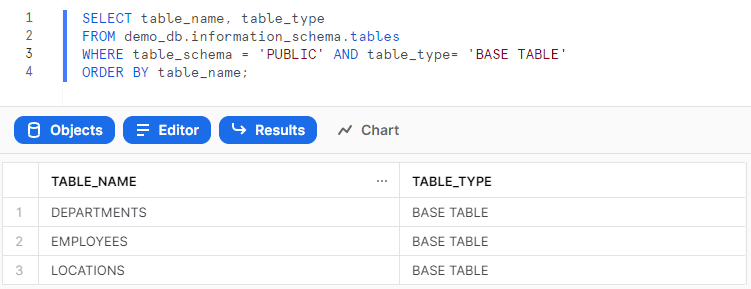1. Cursors in Snowflake Stored Procedures
A Cursor is a named object in a stored procedure which allows you to loop through a set of rows of a query result set, one row at a time. It allows to perform same set of defined actions for each row individually while looping through a result of a SQL query.
Working with Cursors in Snowflake Stored Procedures includes following steps
- Declaring a cursor either in DECLARE or BEGIN…END section of the stored procedure.
- Opening a cursor using OPEN command.
- Fetching rows from cursors using FETCH command.
- Closing a cursor using CLOSE command.
2. Syntax of Cursors in Snowflake Stored Procedures
2.1. Declaring a Cursor
A Cursor must be declared before using it. Declaring a Cursor defines the cursor with a name and the associated SELECT statement.
The syntax for declaring a CURSOR in DECLARE section of the procedure is as follows.
DECLARE
<cursor_name> CURSOR FOR <select_statement>;
-- Example:
DECLARE
my_cursor CURSOR FOR SELECT id, firstname FROM employees;The syntax for declaring a CURSOR in BEGIN…END section of the procedure is as follows.
BEGIN
…
LET <cursor_name> CURSOR FOR <select_statement>;
…
END;
-- Example:
BEGIN
…
LET my_cursor CURSOR FOR SELECT id, firstname FROM employees;
…
END;2.2. Opening a Cursor
The cursor must be explicitly opened before fetching rows from it using OPEN command. The query associated with cursor is not executed until it is opened.
The syntax to OPEN a CURSOR in stored procedure is as follows.
OPEN <cursor_name>;
-- Example:
BEGIN
OPEN my_cursor;
…
END;2.3. Fetching data from Cursor
The FETCH command retrieves row by row from the result set of the query associated with cursor. Each FETCH command that you execute fetches a single row and increments the internal counter to next row.
As a result the FETCH command must be executed multiple times until last row is fetched using looping commands in stored procedures. If a FETCH command is executed after all rows are fetched, it retrieves null values.
The syntax to FETCH data from CURSOR in stored procedures is as follows.
FETCH <cursor_name> INTO <variable_1>,<variable_2>,…;
-- Example:
BEGIN
…
FETCH my_cursor INTO my_variable_1, my_variable_1;
…
END;2.4. Closing a Cursor
The cursor must be closed once all rows are fetched using the CLOSE command.
The syntax to CLOSE a CURSOR in stored procedures is as follows.
CLOSE <cursor_name>;
-- Example:
BEGIN
…
CLOSE my_cursor;
END;3. Setting up a query for Cursor demonstration
The following SELECT query fetches all the tables present in PUBLIC schema of DEMO_DB database. The query uses INFORMATION_SCHEMA which is a data dictionary schema available under each database.
SELECT table_name, table_type
FROM demo_db.information_schema.tables
WHERE table_schema = 'PUBLIC' AND table_type= 'BASE TABLE'
ORDER BY table_name;
Let us use this query as an example and fetch the details of all tables using CURSOR.
4. Cursors using OPEN, FETCH and CLOSE
The following stored procedure fetches details of all the tables present in the PUBLIC schema and lists them as output using Cursors.
CREATE OR REPLACE PROCEDURE sp_demo_cursor()
RETURNS VARCHAR
LANGUAGE SQL
AS
$$
DECLARE
table_cursor CURSOR FOR
SELECT table_name FROM demo_db.information_schema.tables
WHERE table_schema = 'PUBLIC' AND table_type= 'BASE TABLE' ORDER BY table_name;
res VARCHAR DEFAULT '';
var_table_name VARCHAR;
BEGIN
OPEN table_cursor;
LOOP
FETCH table_cursor into var_table_name;
IF(var_table_name <> '') THEN
res := var_table_name ||' '||res;
ELSE
BREAK;
END IF;
END LOOP;
CLOSE table_cursor;
RETURN res;
END;
$$; In the above example:
- In the line 7, the cursor is defined in the DECLARE section of the stored procedure. The cursor is named as
table_cursorand the query discussed in section-3 is associated with cursor. - In the line 13, the cursor is opened using OPEN command.
- From line 14-21, LOOP command is used to loop until all records are fetched from the cursor.
- In the line 15, the FETCH command fetches the
table_namefrom the result set of cursor into variablevar_table_name. - From line 16-19, IF-ELSE clause is used to concatenate the table name values read from the variable
var_table_nameas long as the variable value is not null. Once all the values in the result set are fetched, the logic to explicitly exit the loop using the BREAK command is embedded in the ELSE clause. - In the line 22, the cursor
table_cursoris closed. - In the line 23, the final concatenated value of all table names is returned as output.
The output of the stored procedure sp_demo_cursor is as follows.
CALL sp_demo_cursor();| SP_DEMO_CURSOR |
| LOCATIONS EMPLOYEES DEPARTMENTS |
5. Cursors using FOR Loop command
A FOR loop can also be used to iterate over a result set of a Cursor instead of FETCH command. The number of iterations of the FOR loop is determined by the number of rows in the result set of cursor.
Note that when using a FOR loop to iterate the cursor, the cursor need not be opened explicitly using OPEN command.
The syntax of Cursor-based FOR loops is as follows.
FOR <row_variable> IN <cursor_name> DO
<statement>;
END FOR [ <label> ] ;The <row_variable> holds data of all the columns of the row it is iterating. The individual columns can be accessed as below
<row_variable>.<column1>, <row_variable>.<column2>, ...The following stored procedure fetches details of all the tables present in the PUBLIC schema and lists them as output using Cursor-based FOR loops.
CREATE OR REPLACE PROCEDURE sp_demo_cursor_using_for()
RETURNS VARCHAR
LANGUAGE SQL
AS
$$
DECLARE
table_cursor CURSOR FOR
SELECT table_name, table_type FROM demo_db.information_schema.tables
WHERE table_schema = 'PUBLIC' and table_type= 'BASE TABLE' ORDER BY table_name;
res VARCHAR DEFAULT '';
BEGIN
FOR var in table_cursor DO
res := var.table_name||' '||res;
END FOR;
RETURN res;
END;
$$
;In the above example:
- From line 12-14, the FOR loop is used iterate over the result set of the cursor
table_cursor. - In the line 12, the row variable
varis used to hold the result set values of the query associated with cursor. - In the line 13, the
table_namefield from the result set is accessed using the row variable asvar.table_name. - In the line 15, Once all rows in the result set are iterated, the FOR loop exits and the final concatenated value of all table names is returned.
The output of the stored procedure sp_demo_cursor_using_for is as follows.
CALL sp_demo_cursor_using_for();| SP_DEMO_CURSOR_USING_FOR |
| LOCATIONS EMPLOYEES DEPARTMENTS |
6. Cursors using RESULTSET
Instead of assigning the SELECT query directly to the CURSOR, you can assign a variable of type RESULTSET which holds the query.
The syntax to assign SELECT query to CURSOR using RESULTSET is as follows.
BEGIN
LET <variable_name> RESULTSET := (<select_query>);
LET <cursor_name> CURSOR FOR <variable_name>;
…
END;The following stored procedure fetches details of all the tables present in the PUBLIC schema and lists them as output using RESULTSET to pass query to CURSOR.
CREATE OR REPLACE PROCEDURE sp_demo_cursor_using_resultset()
RETURNS VARCHAR
LANGUAGE SQL
AS
$$
DECLARE
res VARCHAR DEFAULT '';
BEGIN
LET res_set RESULTSET := ( SELECT table_name, table_type FROM demo_db.information_schema.tables
WHERE table_schema = 'PUBLIC' and table_type= 'BASE TABLE' ORDER BY table_name);
LET table_cursor CURSOR FOR res_set;
FOR var in table_cursor DO
res := var.table_name||' '||res;
END FOR;
RETURN res;
END;
$$
;In the above example:
- In the line 9, variable of type RESULTSET named
res_setis assigned with the query is to fetch the list of all table names. - In the line 11, the cursor is assigned with the
res_setvariable instead of query. - The rest of the procedure is same as the example discussed in earlier section.
The output of the stored procedure sp_demo_cursor_using_resultset is as follows.
CALL sp_demo_cursor_using_for();| SP_DEMO_CURSOR_USING_RESULTSET |
| LOCATIONS EMPLOYEES DEPARTMENTS |
7. Cursors using USING clause to pass Bind variables
In the SELECT statement, we can pass bind variables to which values can be passed while opening the cursor in the USING clause of OPEN command.
The following stored procedure fetches details of all the tables present in a schema whose value is passed as a bind variable to the cursor query.
CREATE OR REPLACE PROCEDURE sp_demo_cursor_using_bindvariables(var_schema VARCHAR)
RETURNS VARCHAR
LANGUAGE SQL
AS
$$
DECLARE
table_cursor CURSOR FOR
SELECT table_name, table_type FROM demo_db.information_schema.tables
WHERE table_schema = ? AND table_type= 'BASE TABLE' ORDER BY table_name;
res VARCHAR DEFAULT '';
var_table_name VARCHAR;
BEGIN
OPEN table_cursor using (var_schema);
LOOP
FETCH table_cursor into var_table_name;
IF(var_table_name <> '') THEN
res := var_table_name ||' '||res;
ELSE
BREAK;
END IF;
END LOOP;
CLOSE table_cursor;
RETURN res;
END;
$$
; In the above example:
- In the line 1, the stored procedure is expected to be called by passing value to the input variable
var_schemawhich holds the schema name. - In the line 9, you could see that the schema is passed as bind variable (
?) in the query assigned to the cursor. - In the line 13, the value to the bind variable is passed through
USINGclause ofOPENcommand. - The rest of the procedure is same as what we discussed in the section-3.
The stored procedure sp_demo_cursor_using_bindvariables is executed as below.
CALL sp_demo_cursor_using_bindvariables('PUBLIC');The output of the stored procedure sp_demo_cursor_using_bindvariables is as follows.
| SP_DEMO_CURSOR_USING_BINDVARIABLES |
| LOCATIONS EMPLOYEES DEPARTMENTS |
8. Real-time scenario using a Cursor in Stored Procedures
In all the above examples, we have looped through a SELECT query which lists the names of all tables present in a schema. You might be wondering do we even need cursors to achieve this output.
Well, definitely not !!!
These examples are designed to make you understand about the concept of the cursors. But in real-time, every time you extract the row from a result set of a cursor, an action would be associated with it.
Those actions could be executing any DML statements like UPDATE, DELETE etc.. or calling another stored procedure based on the logic.
So let us also end this article with a real-time useful scenario. In all the above examples we have just listed the table names. Let us extend the same example by extracting the DDL of each table and provide them as output.
The following stored procedure takes database and schema names as input and fetches the DDL of all the tables present inside them as output using Cursors.
CREATE OR REPLACE PROCEDURE sp_get_ddl( var_db_name VARCHAR, var_schema_name VARCHAR)
RETURNS TABLE(DDL VARCHAR)
LANGUAGE SQL
AS
$$
DECLARE
cursor_sql VARCHAR DEFAULT 'SELECT table_name, table_type FROM '||var_db_name||'.information_schema.tables
WHERE table_schema = '''||var_schema_name||''' and table_type= ''BASE TABLE'' ORDER BY table_name';
cursor_resultset RESULTSET DEFAULT (EXECUTE IMMEDIATE :cursor_sql);
table_cursor CURSOR FOR cursor_resultset;
my_sql VARCHAR;
my_union_sql VARCHAR;
res RESULTSET;
counter NUMBER DEFAULT 1;
BEGIN
FOR var in table_cursor DO
my_sql := 'SELECT GET_DDL(''TABLE'','''||var.table_name||''')';
IF(counter=1) THEN
my_union_sql := :my_sql;
ELSE
my_union_sql := :my_union_sql || ' UNION ALL ' || :my_sql;
END IF;
counter := counter + 1;
END FOR;
res := (EXECUTE IMMEDIATE :my_union_sql);
RETURN table(res);
END;
$$
;In the above example:
- In the line 1, the stored procedure
sp_get_ddlaccepts two inputs as variablesvar_db_nameandvar_schema_name, the database and the schema name respectively from which you wanted to extract the DDL of tables. - In the line 2, the RETURN TYPE of the procedure is of type TABLE since we output a bunch of rows each with the DDL of a table.
- In the line 7, we created variable
cursor_sqlof type VARCHAR which holds the SQL to be assigned to cursor as an expression.
The reason for passing SELECT statement as a string expression is that we are passing database name also as a variable in the query which cannot be passed as a bind variable since it is not used as a filter value in the query, but the part of the query itself.
- In the line 9, we are executing the SQL string expression using EXECUTE IMMEDIATE and assigning it to a RESULTSET
cursor_result_set. - In the line 10, finally the cursor
table_cursoris declared and assigned a result setcursor_result_setwhich holds the query. - In the line 16, we are using the FOR command to loop through the result set of the cursor.
- In the line 17, we are creating another SQL string expression
my_sqlwhich provides the DDL of a table.
Since we cannot provide an output in each loop we are performing in Snowflake Stored Procedures, we have to concatenate queries using UNION ALL and form a single query at the end of the loop. The final query which holds the statement to provide DDL of all tables is executed outside the loop and provided as output.
- In the line 18-19, when the counter is 1, we assign the SQL string expression
my_sqlas value to the variablemy_union_sql. The counter is also incremented at the end of iteration. - In the line 20-21, after the initial iteration all the conditions go to ELSE clause and the SQL expression is concatenated to previous values using UNION ALL.
- In the line 25, the output of the final query present in the
my_union_sqlis executed and assigned to a variable of type RESULTSETres. - In the line 26, the variable
resis returned as an output in the form of TABLE.
The stored procedure sp_get_ddl is executed as below with database name as DEMO_DB and schema name as PUBLIC.
CALL sp_get_ddl('DEMO_DB','PUBLIC');The output of the stored procedure sp_get_ddl is as follows.

Checkout other articles related to Snowflake Stored Procedures
Subscribe to our Newsletter !!
Related Articles:

EXECUTE IMMEDIATE command in Snowflake executes SQL statements present in form a character string and returns the result.

IF ELSE, CASE statements in Snowflake Stored Procedures provides a way to execute a set of statements if a condition is met.

Loops in Snowflake Stored Procedures enables you to execute a set of statements until a particular condition is satisfied.




